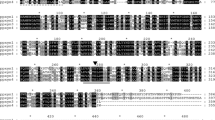Abstract
Oomycetes from the genus Phytophthora are fungus-like plant pathogens that are devastating for agriculture and natural ecosystems. They are able to secrete a glucanase inhibitor protein (GIP) that inhibits the activity of endoglucanases (EGases) involved in defense responses against infection. One of the most widely distributed and aggressive Phytophthora species, with more than 1,000 host plants is P. cinnamomi. In this work we report the sequencing and characterization of a class of GIPs secreted by Phytophthora cinnamomi. The gip gene from P. cinnamomi has a 937 bp ORF encoding a putative peptide of 312 deduced amino acids. The expression of this gene was studied during growth in different carbon sources (glucose, cellulose and sawdust), by RT-qPCR and its level of expression was evaluated at five time points. The highest expression of gip gene occurred in sawdust at 8 h of induction. In vivo infection of C. sativa revealed an increase in gip expression from 12 to 24 h. At 36 h its expression decreased suggesting that a compensatory mechanism must occur in plant.







Similar content being viewed by others
References
Erwin DC, Ribeiro OK (1996) Phytophthora diseases worldwide. American Phytopathological Society Press, St. Paul
Knogge W (1998) Fungal pathogenicity. Curr Opin Plant Biol 1(4):324–328
Hardham AR (2005) Phytophthora cinnamomi. Mol Plant Pathol 6(6):589–604
King M, Reeve W, Van der Hoek MB, Williams N, McComb J, O’Brien PA, Hardy GE (2010) Defining the phosphite-regulated transcriptome of the plant pathogen Phytophthora cinnamomi. Mol Genet Genomics 284(6):425–435
Birch PR, Rehmany AP, Pritchard L, Kamoun S, Beynon JL (2006) Trafficking arms: oomycete effectors enter host plant cells. Trends Microbiol 14(1):8–11
Ellis J, Catanzariti AM, Dodds P (2006) The problem of how fungal and oomycete avirulence proteins enter plant cells. Trends Plant Sci 11(2):61–63
Kamoun S (2007) Groovy times: filamentous pathogen effectors revealed. Curr Opin Plant Biol 10(4):358–365
Schornack S, Huitema E, Cano LM, Bozkurt TO, Oliva R, Van Damme M, Schwizer S, Raffaele S, Chaparro-Garcia A, Farrer R, Segretin ME, Bos J, Haas BJ, Zody MC, Nusbaum C, Win J, Thines M, Kamoun S (2009) Ten things to know about oomycete effectors. Mol Plant Pathol 10(6):795–803
Kamoun S (2003) Molecular genetics of pathogenic oomycetes. Eukaryot Cell 2(2):191–199
Attard A, Gourgues M, Galiana E, Panabieres F, Ponchet M, Keller H (2008) Strategies of attack and defense in plant-oomycete interactions, accentuated for Phytophthora parasitica Dastur (syn. P. Nicotianae Breda de Haan). J Plant Physiol 165(1):83–94
Day B, Graham T (2007) The plant host pathogen interface: cell wall and membrane dynamics of pathogen-induced responses. Ann N Y Acad Sci 1113:123–134
Kamoun S, Huitema E, Vleeshouwers VG (1999) Resistance to oomycetes: a general role for the hypersensitive response? Trends Plant Sci 4(5):196–200
Valueva TA, Mosolov VV (2004) Role of inhibitors of proteolytic enzymes in plant defense against phytopathogenic microorganisms. Biochemistry (Mosc) 69(11):1305–1309
Rose JK, Ham KS, Darvill AG, Albersheim P (2002) Molecular cloning and characterization of glucanase inhibitor proteins: coevolution of a counterdefense mechanism by plant pathogens. Plant Cell 14(6):1329–1345
Raeder U, Broda P (1985) Rapid preparation of DNA from filamentous fungi. Lett Appl Microbiol 1(1):17–20
Michiels MT, Van den Ende W, Van Laere A (2003) Chromosomal walking of flanking regions from short known sequences in GC-rich plant genomic DNA. Plant Mol Biol Rep 21:295–302
Hanahan D (1983) Studies on transformation of Escherichia coli with plasmids. J Mol Biol 166(4):557–580
Sambrook J, Fritsch EF, Maniatis T (1989) Molecular cloning: a laboratory manual, 2nd edn. Cold Spring Harbor Laboratory Press, Cold Spring Harbor
Damasceno CM, Bishop JG, Ripoll DR, Win J, Kamoun S, Rose JK (2008) Structure of the glucanase inhibitor protein (GIP) family from Phytophthora species suggests coevolution with plant endo-beta-1,3-glucanases. Mol Plant Microbe Interact 21(6):820–830
York WS, Qin Q, Rose JK (2004) Proteinaceous inhibitors of endo-beta-glucanases. Biochim Biophys Acta 1696(2):223–233
Liu B, Xue X, Cui S, Zhang X, Han Q, Zhu L, Liang X, Wang X, Huang L, Chen X, Kang Z (2010) Cloning and characterization of a wheat beta-1,3-glucanase gene induced by the stripe rust pathogen Puccinia striiformis f. sp. tritici. Mol Biol Rep 37(2):1045–1052
Murfett J, Wang XJ, Hagen G, Guilfoyle TJ (2001) Identification of Arabidopsis histone deacetylase HDA6 mutants that affect transgene expression. Plant Cell 13(5):1047–1061
Horta M, Sousa N, Coelho AC, Neves D, Cravador A (2009) In vitro and in vivo quantification of elicitin expression in Phytophthora cinnamomi. Physiol Mol Plant P 73:48–57
Staskawicz BJ (2001) Genetics of plant-pathogen interactions specifying plant disease resistance. Plant Physiol 125(1):73–76
Shiraishi T, Yamada T, Ichinose Y, Kiba A, Toyoda K (1997) The role of suppressors in determining host–parasite specificities in plant cells. Int Rev Cytol 172:55–93
Acknowledgments
This work was financially supported by the EC - III Framework Programme for Research and Technological Development, co-financed by the European Social Fund (ESF) and by national funding from the Portuguese Ministério da Ciência e do Ensino Superior (MCES) (PTDC/AGR-AAM/67628/2006).
Author information
Authors and Affiliations
Corresponding author
Rights and permissions
About this article
Cite this article
Martins, I.M., Martins, F., Belo, H. et al. Cloning, characterization and in vitro and in planta expression of a glucanase inhibitor protein (GIP) of Phytophthora cinnamomi . Mol Biol Rep 41, 2453–2462 (2014). https://doi.org/10.1007/s11033-014-3101-1
Received:
Accepted:
Published:
Issue Date:
DOI: https://doi.org/10.1007/s11033-014-3101-1




